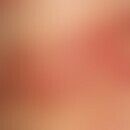HistoryThis section has been translated automatically.
Shabbir et al. (1986); Shabbir et al. first described an autosomal recessive syndrome of junctional epidermolysis bullosa, which they termed the laryngo-onycho-cutaneous syndrome, in 22 patients in 12 families in 1986, in Lahore, Pakistan.
Ainsworth et al (1992) studied 27 affected children in 18 families. The study group proposed the name LOGIC syndrome for "laryngeal and ocular granulations in children from the Indian subcontinent."
DefinitionThis section has been translated automatically.
Laryngo-onycho-cutaneous syndrome (LOC) is a rare, autosomal recessive subtype of localized, (not generalized) junctional epidermolysis bullosa caused by a homozygous mutation in LAM3 (18q11.2). Described are <50 cases characterized by abnormal granulation tissue formation in the skin. To date, three mutations, including the specific (founder) mutation in exon 39 of LAMA3 have been identified (Prodinger C et al. 2021).
You might also be interested in
EtiopathogenesisThis section has been translated automatically.
Detectable biallelic mutations are laminin alpha-3 (LAMA3; 600805; gene locus:18q11.2). The gene encodes three different laminins (laminin alpha-3a, alpha-3b1, and alpha-3b2) formed by alternative splicing (McLean et al. 2003). These proteins are secreted only by the basal keratinocytes of stratified epithelia, suggesting that LOCS is caused by a disruption of keratinocyte-mesenchymal communication. It is likely that the N-terminal domain of laminin alpha-3a is an important regulator of granulation tissue reaction.
This would explain the abnormal growth of granulation tissue in different parts of the body. In people with LOC syndrome, granulation tissue forms even when there was no visible injury.
ClinicThis section has been translated automatically.
The most common cutaneous feature of LOC syndrome is extensive poorly healing erosions. The lesional areas are characterized by excessive granulation tissue. There is a tendency for these areas to become infected. An early clinical manifestation is a conspicuous hoarseness during crying due to involvement of the larynx. This symptomatology is caused by excess granulation tissue in the area of the larynx. This can complicatively block the airways, possibly leading to life-threatening respiratory problems.
The conjunctiva are also severely affected. The inflammation localized there can lead to blindness. Furthermore, persons with LOC syndrome are characterized by malformed nails and often by small, abnormal teeth. (Note: the disturbances in tooth enamel lead to conspicuous caries).
Other methods of examination This section has been translated automatically.
Electron microscopy: Abnormal hemidesmosomes are detectable.
Immunologically, Phillips et al (1994) demonstrated unusually weak immunoreactivity with antibodies to basal cell proteins.
Note(s)This section has been translated automatically.
Phillips et al (1994) described three unrelated children of Pakistani descent. All of them developed laryngeal abnormalities, chronic skin ulceration, nail dystrophy, and conjunctival disease in infancy. In all cases, enamel was hypoplastic and both skin and mucosal surfaces showed increased susceptibility to trauma. The disease resulted in life-threatening airway obstruction in two patients and blindness and fatal airway obstruction in the third child.
In affected members of 15 consanguineous Punjabi families with LOCS, McLean et al (2003) identified a homozygous frameshift mutation in the LAMA3 gene (151insG; 600805.0004) that predicts a stop codon in an exon specific for laminin alpha-3a.
LiteratureThis section has been translated automatically.
- Ainsworth JR et al (1991) Laryngeal and ocular granulation tissue formation in two Punjabi children: LOGIC syndrome. Eye 5: 717-722.
- Ainsworth JR et al (1992) Multisystem disorder of Punjabi children exhibiting spontaneous dermal and submucosal granulation tissue formation: LOGIC syndrome. Clin Dysmorph 1: 3-14.
- McLean WHI et al. (2004) An unusual N-terminal deletion of the laminin alpha-3a isoform leads to the chronic granulation tissue disorder laryngo-onycho-cutaneous syndrome. Hum Molec Genet 12: 2395-2409.
- Phillips RJ et al (1994) Laryngo-onycho-cutaneous syndrome: an inherited epithelial defect. Arch Dis Child 70: 319-326.
- Prodinger C et al (2021) The natural history of laryngo-onycho-cutaneous syndrome: A case series of six pediatric patients and literature review. Pediatr Dermatol 38:1094-1101.
- Ranugha Pet al. (2020) A novel mutation in LAMA3A gene in a child with laryngo-onycho-cutaneous syndrome from the Indian subcontinent. Indian J Dermatol Venereol Leprol 86:555-559.
- Shabbir G et al (1986) Laryngo-onycho-cutaneous syndrome: a study of 22 cases. Biomedica 2: 15-25.
Incoming links (1)
LAMA3 Gene;Outgoing links (1)
LAMA3 Gene;Disclaimer
Please ask your physician for a reliable diagnosis. This website is only meant as a reference.




